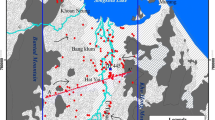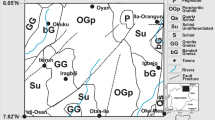Abstract
Data integration is challenging where there are different levels of support between primary and secondary data that need to be correlated in various ways. A geostatistical method is described, which integrates the hydraulic conductivity (K) measurements and electrical resistivity data to better estimate the K distribution in the Upper Chicot Aquifer of southwestern Louisiana, USA. The K measurements were obtained from pumping tests and represent the primary (hard) data. Borehole electrical resistivity data from electrical logs were regarded as the secondary (soft) data, and were used to infer K values through Archie’s law and the Kozeny-Carman equation. A pseudo cross-semivariogram was developed to cope with the resistivity data non-collocation. Uncertainties in the auto-semivariograms and pseudo cross-semivariogram were quantified. The groundwater flow model responses by the regionalized and coregionalized models of K were compared using analysis of variance (ANOVA). The results indicate that non-collocated secondary data may improve estimates of K and affect groundwater flow responses of practical interest, including specific capacity and drawdown.
Résumé
L’intégration de données entre en jeu lorsque plusieurs niveaux intermédiaires d’assistance sont nécessaires pour corréler données primaires et secondaires de diverses manières. Le présent article décrit une méthode géostatistique qui intègre les mesures de conductivité hydraulique (K) et les données de résistivité électrique, afin d’estimer plus efficacement la distribution de K dans l’Aquifère Supérieur de Chicot, au sud-ouest de la Louisiane (Etats-Unis). Les mesures de K sont issues des pompages d’essai et représentent les données primaires (“dures”). Les données des diagraphies de résistivité électrique ont été considérées comme des données secondaires (“molles”), à partir desquelles les valeurs de K ont été déduites, par la loi d’Archie et l’équation de Kozeny-Carman. Un pseudo semi-variogramme croisé a été développé afin de pallier à l’absence de colocalisation des données de résistivité. Les incertitudes sur les semi-variogrammes automatiques et sur les pseudo semi-variogrammes croisés ont été quantifiées. Les réponses du modèle d’écoulement des eaux souterraines aux modèles régionalisés et co-régionalisés de K ont été comparés, par les analyses de variance (ANOVA). Les résultats montrent que les données secondaires non-colocalisées peuvent améliorer les estimations de K, et affecter efficacement les réponses des écoulements souterrains, y compris les débits spécifiques et les rabattements.
Resumen
La integración de datos es un gran desafío cuando existen diferentes niveles de apoyo entre datos primarios y secundarios que es necesario correlacionar de varias maneras. Se describe un método geoestadístico el cual integra mediciones de conductividad hidráulica (K) y datos de resistividad eléctrica para tener una mejor estimación de la distribución de K en el Acuífero Chicot Superior del suroeste de Luisiana, Estados Unidos de América. Las mediciones de K se obtuvieron de pruebas de bombeo y representan los datos primarios (duros). Los datos de sondeos de resistividad eléctrica se consideraron como datos secundarios (suaves) y se usaron para inferir valores de K a través de la ley de Archie y la ecuación de Carman-Kozeny. Se desarrolló un pseudo semivariograma cruzado para enfrentar la falta de colocación de datos de resistividad. Se cuantificaron las incertidumbres en los auto-semivariogramas y en los semivariogramas cruzados. Las respuestas del modelo de flujo de agua subterránea por los modelos coregionalizados y regionalizados de K se compararon usando el análisis de varianza (ANOVA). Los resultados indican que los datos secundarios no colocados pueden mejorar los estimados de K y afectar las respuestas de flujo de agua subterránea de interés práctico, incluyendo capacidad específica y descenso.








Similar content being viewed by others
References
Archie GE (1942) The electrical resistivity logs as an aid in determining some reservoir characteristics, AIME Trans 146:54–62
Asquith GB, Gibson CR (1982) Basic well log analysis for geologists. American Association of Petroleum Geologists Methods in Exploration Series 3, The American Association of Petroleum Geologists, Tulsa, OK, USA, 216 pp
Boman GK, Molz FJ, Guven O (1995) An evaluation of interpolation methodologies for generating three dimensional hydraulic property distribution from measured data. Ground Water 33(2):247–258
Bradbury KR, Rothschild ER (1985) A computerized technique for estimating the hydraulic conductivity of aquifers from specific capacity data. Ground Water 23(2):240–246
Carlson D, Milner R, Hanson B (2003) Evaluation of the aquifer capacity to sustain short–long term groundwater withdrawal from point sources in the Chicot Aquifer for southwest Louisiana, part 1. Report of Investigation Series 03–01, 90, Louisiana Geological Survey, Baton Rouge, LA
Carman PC (1956) Flow of gases through porous media. Butterworths, London
Carrera J, Neuman SP (1986) Estimation of aquifer parameters under transient and steady-state conditions. 1. Maximum-likelihood method incorporating prior information. Water Resour Res 22:199–210
Clark I, Basinger K, Harper W (1989) MUCK: a novel approach to co-kriging. In: Buxton BE (ed) Proceedings of the Conference on Geostatistical, Sensitivity and Uncertainty: methods for groundwater flow and radionuclide transport modeling. Battelle Press, Columbus, OH, USA, pp 473–494
Cressie N (1985) Fitting variogram models by weighted least squares. J Int Assoc Math Geol 17:563–586
Deutsch CV, Journel AG (1998) GSLIB: geostatistical software library and users guide, 2nd edn. Oxford University Press, New York, 369 pp
Domenico PA, Schwartz FW (1990) Physical and chemical hydrogeology. Wiley, New York
Donnelly-Makoweckia LM, Moore RD (1999) Hierarchical testing of three rainfall-runoff models in small forested catchments. J Hydrol 219:136–152
Eggleston JR, Rojstaczer SA, Pierce JJ (1996) Identification of hydraulic conductivity structure in sand and gravel aquifers: Cape Cod data set. Water Resour Res 32(5):1209–1222
Feyen L, Ribeiro PJ, De Smedt F, Diggle PJ et al (2003) Stochastic delineation of capture zones: classical versus Bayesian approach. J Hydrol 281(4):313–324
Fisher RA (1935) The design of experiments. Oliver and Boyd, Edinburgh, UK
Fogg GE (1986) Groundwater-flow and sand body interconnectedness in a thick, multiple-aquifer system. Water Resour Res 22(5):679–694
Gloaguen E, Chouteau M, Marcotte D, Chapuis R (2001) Estimation of hydraulic conductivity of an unconfined aquifer using cokriging of GPR and hydrostratigraphic data. J Appl Geophys 47(2):135–152
Goovaerts P (1997) Geostatistics for natural resources evaluation. Oxford University Press, New York, 483 pp
Hanson B, Milner R, Willson C, Rahman A, Paulsell R (2001) Evaluation of aquifer capacity to sustain long term ground water withdrawal from point sources: a pilot study. Report to the Louisiana Department of Natural Resources, Baton Rouge, 171 pp
Harbaugh AW, McDonald MG (1996) User’s documentation for MODFLOW-96, an update to the U.S. geological survey modular finite-difference ground-water flow model. US Geol Surv Open-File Rep 96–485, 56 pp
Hohn ME (1998) Geostatistics and petroleum geology, 2nd edn. Kluwer, Dordrecht, The Netherlands, 248 pp
Ikem A, Osibanjo O, Sridhar MKC, Sobande A (2002) Evaluation of groundwater quality characteristics near two waste sites in Ibadan and Lagos, Nigeria. Water Air Soil Poll 140:307–333
Kelly WE (1977) Geoelectric sounding estimating aquifer hydraulic conductivity. Ground Water 15(6):420–425
Kitanidis PK (1986) Parameter uncertainty in estimation of spatial functions: Bayesian-analysis. Water Resour Res 22(4):499–507
Kitanidis PK, Vomvoris EG (1983) A geostatistical approach to the inverse problem in groundwater modeling (steady state) and one-dimensional simulations. Water Resour Res 19(3):677–690
Koltermann C, Gorelick SM (1996) Creating images of heterogeneity in sedimentary deposits: a review of descriptive, structure-imitating, and process-imitating approaches. Water Resour Res 32(9):2617–2658
Kosinski WK, Kelly WE (1981) Geoelectric soundings for predicting aquifer properties. Ground Water 19(2):163–171
Leake SA, Claar DV (1999) Procedures and computer programs for telescopic mesh refinement using MODFLOW. US Geol Surv Open-File Rep 99–238, 53 pp
McLaughlin D, Townley LR (1996) A reassessment of the groundwater inverse problem. Water Resour Res 32(5):1131–1162
Myers DE (1991) Pseudo-cross variograms, positive definiteness and cokriging. Math Geol 23:805–816
Neuman SP (1990) Universal scaling of hydraulic conductivities and dispersivities in geologic media. Water Resour Res 26(8):1749–1758
Ortiz CJ, Deutsch CV (2002) Calculation of uncertainty in the variogram. Math Geol 34(2):169–183
Poeter EP, Gaylord DR (1990) Influence of aquifer heterogeneity on contaminant transport at the Hanford site. Ground Water 28(6):900–909
Rahman A (2005) Improvements in groundwater flow modeling through the integration of resistivity logs and hydraulic conductivity and the use of variogram uncertainty, PhD Thesis, Louisiana State University, USA, 104 pp
Rehfeldt KT, Boggs JM, Gelhar LW (1992) Field-study of dispersion in a heterogeneous aquifer. 3. Geostatistical analysis of hydraulic conductivity. Water Resour Res 28(12):3309–3324
Ritzi RW, Jayne DF, Zahradnik AJ, Field AA, Fogg GE (1994) Geostatistical modeling of the heterogeneity in glaciofluvial buried-valley aquifers. Ground Water 32(4):666–674
Rong Y (2002) Groundwater data analysis for MTBE relative to other oxygenates at gasoline-impacted sites 9(4):184–190
Sargent P (2002) Water use in Louisiana, 2000, Special Report no. 15, Department of Transportation and Development Water Resources, Baton Rouge, LA, USA
Vukovic M, Soro A (1992) Determination of hydraulic conductivity of porous media from grain-size composition. Water Resources Publications, Highlands Ranch, CO, USA, pp 1–83
Weight WD, Sonderegger JL (2001) Manual of applied field hydrogeology, McGraw-Hill, New York, 608 pp
Acknowledgements
The research was partially supported by Louisiana Department of Transportation and Development; Louisiana Geological Survey; and Louisiana State University Faculty Research Grant Program. Special thanks go to C.V. Deutsch, Dept. of Civil and Environmental Engineering, University of Alberta, Canada for his invaluable discussion. We also acknowledge the help from R. Milner of the Louisiana Geological Survey for resistivity-log data interpretation.
Author information
Authors and Affiliations
Corresponding author
Rights and permissions
About this article
Cite this article
Rahman, A., Tsai, F.TC., White, C.D. et al. Geophysical data integration, stochastic simulation and significance analysis of groundwater responses using ANOVA in the Chicot Aquifer system, Louisiana, USA. Hydrogeol J 16, 749–764 (2008). https://doi.org/10.1007/s10040-007-0258-x
Received:
Accepted:
Published:
Issue Date:
DOI: https://doi.org/10.1007/s10040-007-0258-x




